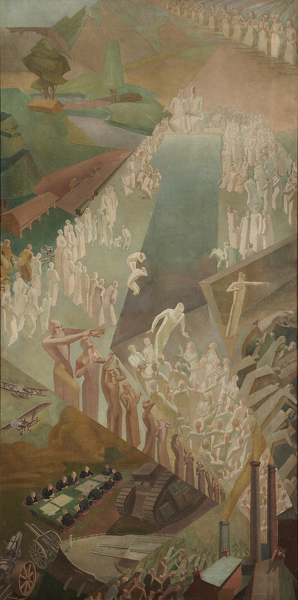
Allegory of War, early 1920's
Framed (ref: 10133)
Oil on canvas
59 1/2 x 29 3/4 in. (151 x 75.5 cm)
Tags: English School oil allegory landscape transport war RELIGION Works for Paris

Oil on canvas
59 1/2 x 29 3/4 in. (151 x 75.5 cm)
Tags: English School oil allegory landscape transport war RELIGION Works for Paris
Provenance: Private collection, 1980's; Tadema Gallery until 2018
The author of this Allegory is currently unknown. Clearly the artist was familiar with the Vorticist compositions of Bomberg, Gertler, Spencer, Roberts, Wyndham Lewis, though not necessarily a student as the composition is highly accomplished. The palette is very closely controlled and distinctive, resting predominantly within hues of brown and green. The treatment of the figures brings to mind Stanley Spencer, especially with the suggestion of Resurrection: the figures in the lower left are either disappearing into the green ground or emerging from it. Tom Nash or early Henry Lamb also come to mind. Sarah MacDougal has pointed out that ere are many points about the style that suggest a Slade-trained artist. It has intimations of Stanley Spencer in the redemptive theme, and of Bomberg in the emergence of the figures from grid-like areas of the composition and their beseeching gestures, while the intimations of warfare in the shape of planes, tanks and cannon, are reminiscent both of Roberts' commissioned warwork and that of Wyndham Lewis - though less harshly stylised.
The graphic quality brings to mind print makers such as Blair Hughes Stanton, Getrude Hermes and Lynd Ward. The subject matter brings to mind of the tract produced by the angry pacifist socialist Arthur Wragg, 'Jesus Wept', published by Selwyn & Blount London (1934)
The subject would appear to be an Allegory (of War and Peace?). The figures at a conference table could be a reference to Versailles or possibly the Locarno Treaty – signed October 1925; that would chime with the works disarmament theme thought it isn’t clear if the tank and the warship are being discarded or emerging from a factory. If the latter they might be discussing war strategy. But the men round the conference table are wearing civilian suits, there is not a single uniform amongst them, so most likely are planning post-war reconstruction, the remodelling of industry away from munitions and the return to peace.
Certain elements help date this painting - The Royal Flying Corps had similar seaplanes to the one shown as early as 1914. Tanks of this shape were built in Britain from 1916 to 1919 (through a number of Marks or models). The rhomboid image of the WW1 tank was used in images, toys and souvenirs in popular culture as ‘new’ until the mid nineteen twenties when images of the new Vickers medium tank – with a turret – took over. Probably this is a Mark V Heavy Battle Tank of the kind used in France in the summer of 1918 – notably in the Battle of Amiens. In the lower left hand corner there is a 9.2 inch siege howitzer – same calibre as the gun on Jagger’s Hyde Park Corner artillery memorial (unveiled October 1925).
The shape is very distinctive- almost as if this was for a mural scheme; perhaps a Memorial after WW1. If that were the case it is so highly evolved that it might be a proposal or a finished design; possibly one of several panels for a site specific commission. However most permanent memorial sites were pretty orthodox with an emphasis on valour and nationhood, which would make this (proposed?) scheme something out of the ordinary.
We are grateful to Jonathan Dr. Jonathan Black, Emma Mawdsley, Ian Jack, David Willey, Dr Gill Clarke, Andrew Cormack, Roger Bowdler and Sarah MacDougal for assistance